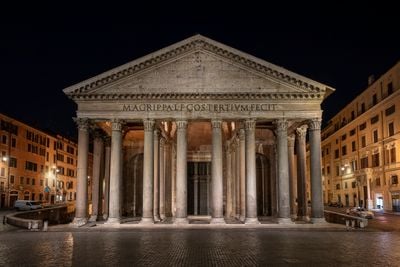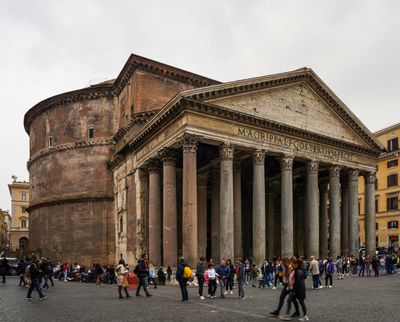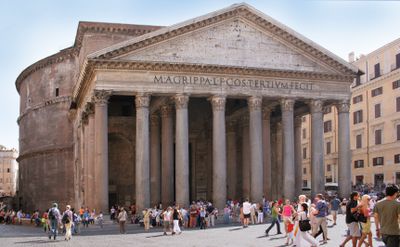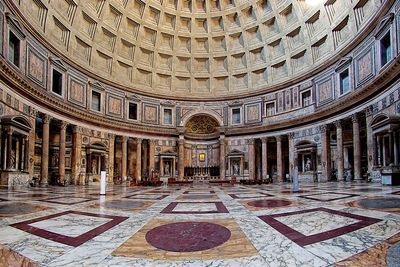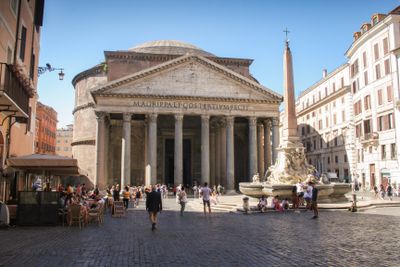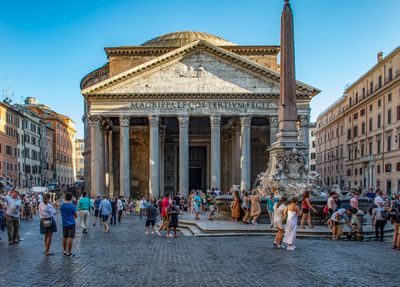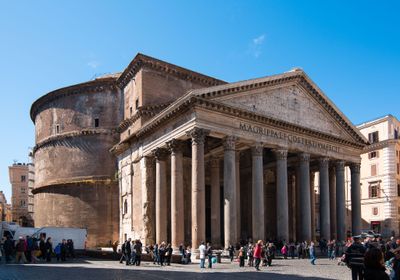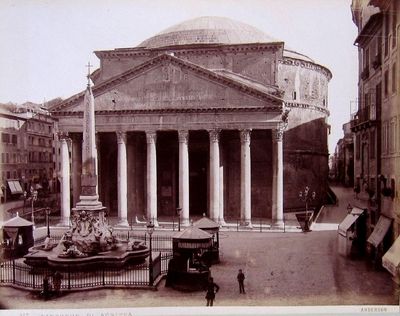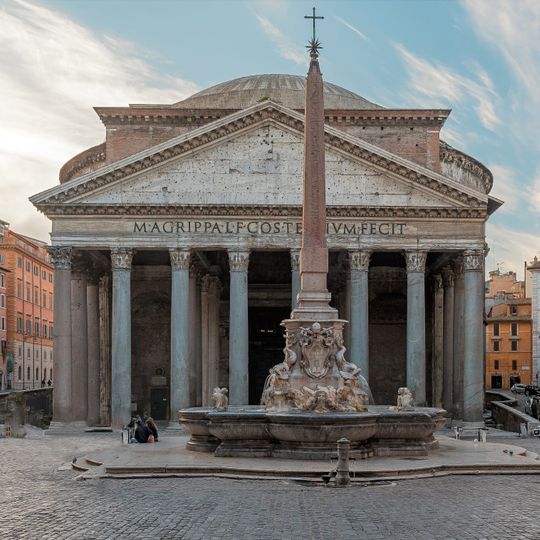
Pantheon
Pantheon, Roman temple in Pigna district, Rome, Italy
The Pantheon is a Roman temple in the Pigna district of central Rome. The structure features a cylindrical brick rotunda measuring 43 meters in diameter, crowned by a hemispherical concrete vault with a central opening of 9 meters as the sole light source.
Marcus Agrippa built an initial temple here in 27 BCE, which was destroyed by fire under Emperor Domitian. Emperor Hadrian had the current building erected between 113 and 125 CE, and Pope Boniface IV consecrated it as a Christian church in 609, preventing medieval looting.
As a Catholic church, the building holds the tombs of Italian kings Victor Emmanuel II and Umberto I, as well as the painter Raphael. Visitors experience both religious services and the quiet respect paid to these historical figures who shaped Italian national identity.
Entry is free and the building sits centrally in the old town, just a few minutes walk from Piazza Navona and Trevi Fountain. Visitors should arrive early in the morning to avoid crowds and wear modest clothing as this remains an active church.
The vault was cast using Roman concrete with pozzolanic volcanic ash and graduated material layers, employing lighter pumice stone at the apex to reduce weight. This ancient technique allowed the unreinforced structure to endure nearly two millennia without steel reinforcement or modern support systems.
Location: Rome
Inception: 2 century
Architects: Apollodorus of Damascus
Architectural style: ancient Roman architecture
Height: 43.3 m
Length: 35 m
Width: 54.5 m
Accessibility: Wheelchair accessible
Fee: Yes
Made from material: concrete
Address: Piazza della Rotonda
Opening Hours: Monday-Saturday 08:30-19:15; Sunday 09:00-17:45
Phone: +390668300230
Email: pm-laz@beniculturali.it
Website: http://pmlaz.beniculturali.it
GPS coordinates: 41.89861,12.47694
Latest update: December 2, 2025 21:02
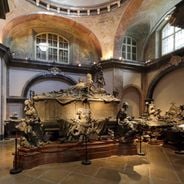
These burial sites across Europe hold the remains of nobility and document the stories of ruling families through the centuries. From the grand Kaisergruft in Vienna to the solemn chapels of Windsor Castle, each location shows how different societies honored their dead. The buildings range from Roman structures thousands of years old to chapels built in recent centuries, displaying how architectural styles changed over time. Many of these sites blend religious spaces with royal tombs, creating places of both spiritual meaning and historical record. In Paris, the Chapelle Expiatoire marks a turning point in French history. In Rome, the Pantheon and other ancient monuments survived from classical times. London's Westminster Abbey and Highgate Cemetery show how British nobility chose to be remembered. St. Petersburg's cathedrals display the grandeur of imperial Russia, while Florence's Medici Chapels reveal the power of banking families in Renaissance Italy. These places offer visitors a chance to walk through European history. You encounter the tombs of kings and queens, see the art and decoration that surrounded them, and understand how different regions treated their most important figures. Whether visiting a simple memorial or a sprawling mausoleum, you gain insight into what mattered to European societies across different eras.
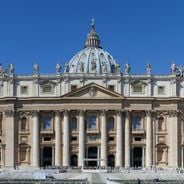
This collection brings together notable domes and cupolas from all continents, signs of diverse architectural traditions extending from the Vatican to Australia, Russia to the United Arab Emirates. From the famous dome of St. Peter's Basilica in Rome to the colorful domes of the Church of the Savior on Spilled Blood in Saint Petersburg, the Renaissance dome of Florence Cathedral, to the cast-iron dome of the US Capitol in Washington, each structure tells a particular story and reflects the ambitions of its era. These buildings span several centuries of architectural innovation and serve various functions: religious structures like the Sheikh Zayed Grand Mosque or the Basilica of Our Lady of Peace in Côte d'Ivoire, civil buildings such as Oxford's Radcliffe Camera or the Australian Exhibition Palace, and even thermal spas like Budapest’s Széchenyi Baths. Each dome illustrates construction techniques and aesthetic decisions specific to its culture, offering insight into skills that enabled the creation of these monumental coverings.
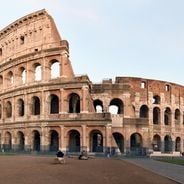
Circular architecture has fascinated builders since ancient times. This collection brings together Roman amphitheatres like the Colosseum, medieval towers such as the Round Tower in Copenhagen, baroque domed structures and modern constructions. The circular form offers practical advantages for acoustic properties, structural stability and optimal space usage. The selected buildings serve various functions: religious temples, fortifications, observatories, museums and event venues. Each example demonstrates how architects have adapted the circular form to local conditions and cultural requirements. From ancient stone structures to contemporary skyscrapers, this selection documents technical evolution across centuries.
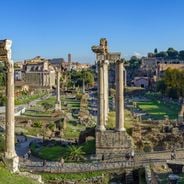
Rome preserves more than 2,000 years of architectural history within its city limits, maintaining ancient temples and amphitheaters beside Renaissance churches and Baroque piazzas. The Roman Forum displays ruins from the first century BC through the fourth century AD, including government buildings and temples that formed the administrative heart of the Roman Empire. The Pantheon demonstrates Roman engineering with its concrete dome, while the Colosseum remains the largest ancient amphitheater ever built. The city evolved through subsequent centuries as papal patronage transformed medieval Rome into a showcase of Renaissance and Baroque art and architecture. The Vatican holds significant religious and artistic collections, including the Sistine Chapel with Michelangelo's ceiling frescoes and Saint Peter's Basilica, the world's largest church building. Throughout the historic center, public squares like Piazza Navona preserve the footprint of ancient Roman structures while displaying Baroque fountains by Bernini and Borromini. The Trevi Fountain draws thousands of visitors daily to its 18th century facade, and the Spanish Steps connect different elevation levels of the city. Rome's neighborhoods maintain traditional Italian life around these monuments, with restaurants, shops and residences occupying buildings from various historical periods.

Rome contains over 900 churches that demonstrate two thousand years of sacred architecture, from Roman antiquity to the Baroque period. These buildings reveal the evolution of construction techniques and artistic expressions over the centuries. St. Peter's Basilica covers 20,000 square meters and features a dome designed by Michelangelo. The Pantheon retains its Roman dome with a 43-meter (141 feet) diameter, the largest ever constructed in unreinforced concrete. Major basilicas such as Santa Maria Maggiore showcase Byzantine mosaics from the 5th century beneath a Renaissance ceiling with gilded coffers. Saint Clement's Basilica in the Lateran overlays three levels of construction from the 1st to the 12th centuries, illustrating Rome's urban stratification. Santa Maria in Trastevere, one of the city's oldest churches, presents medieval gilded mosaics, while Saint Peter's in Chains houses Michelangelo's Moses. These monuments help understand how Rome shaped European religious architecture for over fifteen centuries.

Rome joins history with modern photography. The city spreads across several hills and holds buildings from different centuries, from ancient ruins to baroque churches and fountains. Photographers find subjects on every street corner, from large public squares to narrow alleys in old neighborhoods. The Colosseum and Roman Forum show the building techniques of ancient Rome. Trevi Fountain and Piazza Navona present baroque design with flowing water and sculptures. The Spanish Steps serve as a meeting point where people rest on the steps and watch the activity below. The Pantheon has stood for nearly 2,000 years and impresses through its dome with a circular opening at the center. In Vatican City, St. Peter's Basilica rises with its tall dome, and the Vatican Museums contain long galleries filled with artworks. Castel Sant'Angelo stands by the Tiber River and offers a wide view over the city's rooftops from above. Trastevere sits on the other side of the river and shows a different face of Rome: small squares, narrow streets with laundry lines between buildings, and restaurants with tables on the pavement. The church of Santa Maria in Trastevere has a golden mosaic on its facade that glows in the evening light. Campo de' Fiori is a market in the morning with vegetables and flowers, and in the evening the square fills with people. Via Margutta is a quiet street with galleries and plants on the building walls. The Aventine Keyhole shows St. Peter's Dome through a small opening in perfect framing. The Janiculum hill and Villa Borghese Gardens offer green spaces for walking and views over the city. Caracalla Baths and the Appian Way show Rome outside the center, where ancient structures stand in the landscape.

Italy preserves architectural evidence from two thousand years of history. In Rome, Roman temples stand beside Renaissance palaces, while Florence houses museums and cathedrals from the 15th century. Venice developed its canal system over centuries as a response to its lagoon environment. In the Campania region, Mount Vesuvius shapes the landscape, and the ancient city of Pompeii has remained preserved under volcanic ash since the 1st century.

Campus Martius
96 m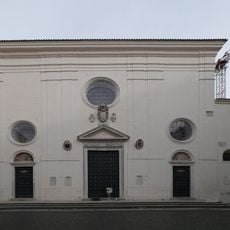
Santa Maria sopra Minerva
131 m
Palazzo Giustiniani
152 m
Elephant and Obelisk
87 m
Cristo della Minerva
133 m
Sant'Eustachio
99 m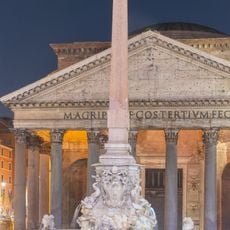
Fountain of the Pantheon
70 m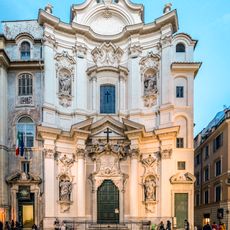
Santa Maria Maddalena
164 m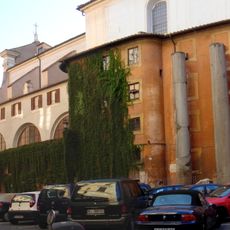
Baths of Nero
93 m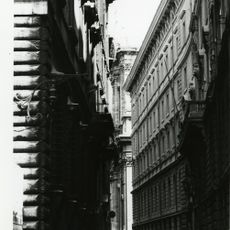
Palazzo San Macuto
135 m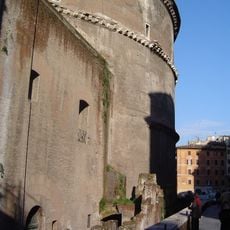
Saepta Julia
94 m
Carafa Chapel
122 m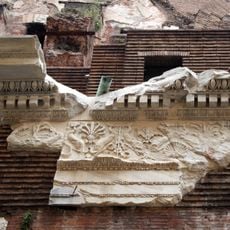
Basilica of Neptune
39 m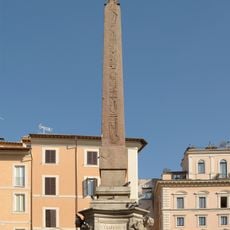
Macuteo obelisk
79 m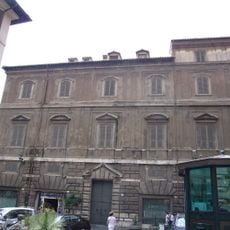
Palazzo Maccarani Stati
136 m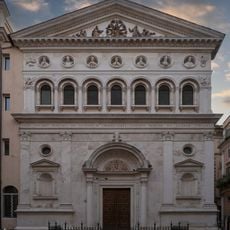
Santa Chiara
146 m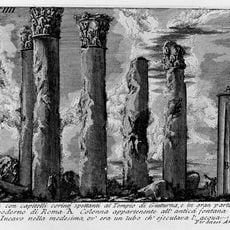
Temple of Matidia
136 m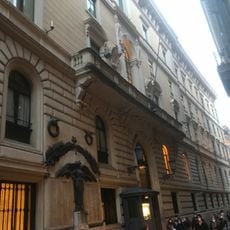
Library of the Chamber of the Deputies, Rome
151 m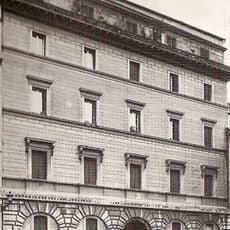
Palazzo Mazzetti di Pietralata
171 m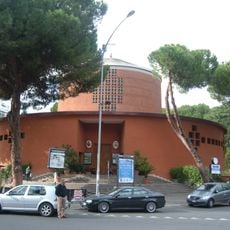
Santa Chiara
129 m
Organo della basilica di Sant'Eustachio a Roma
99 m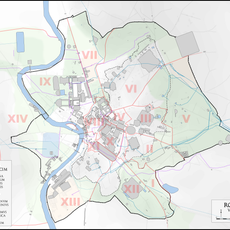
Bibliothèque du Panthéon
32 m
Palazzo della Minerva
70 m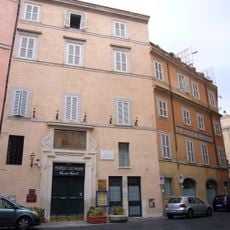
Cappella del Transito di Santa Caterina da Siena
105 m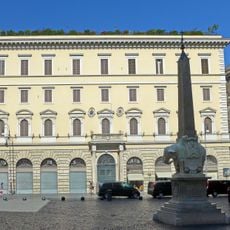
Severoli Palace
79 m
Fontanella di Vicolo della Spada d'Orlando
131 m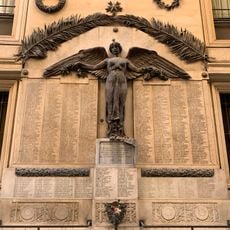
Monumento ai Postelegrafonici Caduti nella Grande Guerra
131 m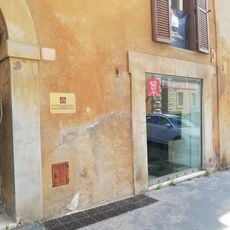
Biblioteca della Fondazione Lelio e Lisli Basso. Onlus
145 mVisited this place? Tap the stars to rate it and share your experience / photos with the community! Try now! You can cancel it anytime.
Discover hidden gems everywhere you go!
From secret cafés to breathtaking viewpoints, skip the crowded tourist spots and find places that match your style. Our app makes it easy with voice search, smart filtering, route optimization, and insider tips from travelers worldwide. Download now for the complete mobile experience.

A unique approach to discovering new places❞
— Le Figaro
All the places worth exploring❞
— France Info
A tailor-made excursion in just a few clicks❞
— 20 Minutes

